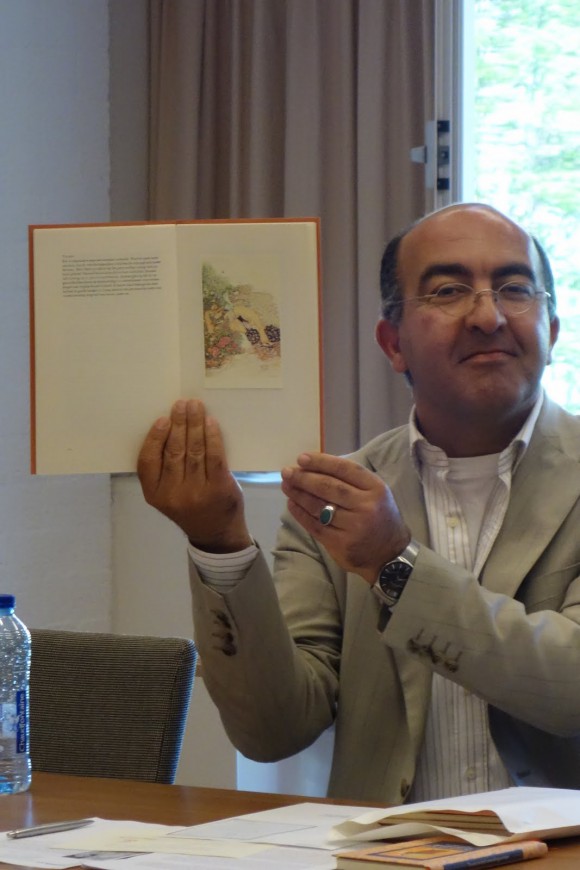Two new titles have been published recently:
Rubá’iyát of Hakim ‘Umar Khayyám. Selected quatrains of Khayyám. Translated into simple 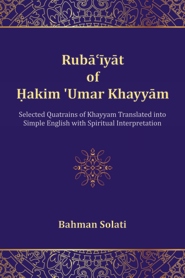 English with spiritual interpretation. Edited and translated by Bahman Solati. Boca Raton, Universal-publishers, 2015. 109 pp. ISBN: 978-1-62734-033-5.
English with spiritual interpretation. Edited and translated by Bahman Solati. Boca Raton, Universal-publishers, 2015. 109 pp. ISBN: 978-1-62734-033-5.
In this edition 60 quatrains are literally translated and presented with a spiritual explanation and with the Persian text of the quatrains. The introduction (20 pages) highlights the most important facts, features and history of Khayyám’s rubáiyat. Solati published a number of studies on Hafez, as well as on the impact of Sufism on post-Islamic Persian literature.
The 108 quatrains of Omar Khayyam. Persian – English – Chinese. [Selection and translation] Sen 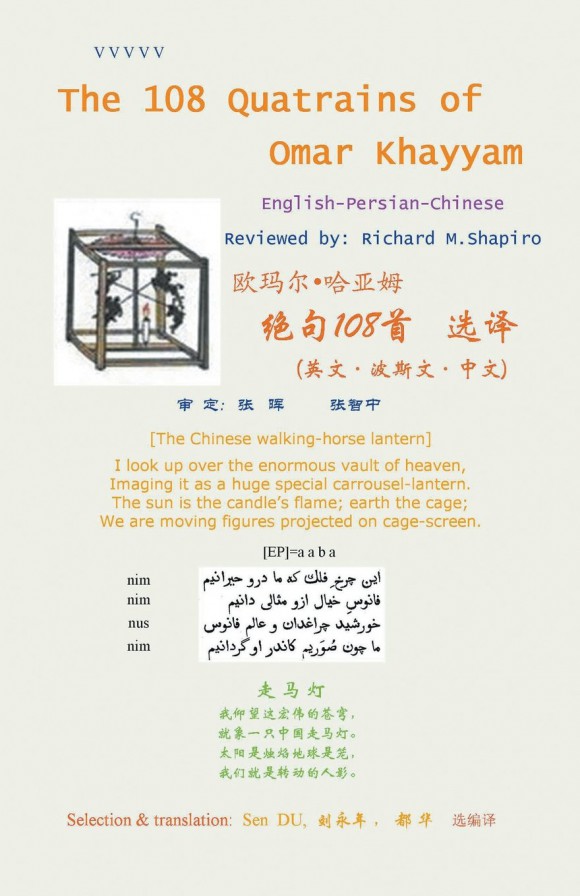 Du. Litfire Publishing, 2015. 148 pp. ISBN: 978-1-942296-75-1.
Du. Litfire Publishing, 2015. 148 pp. ISBN: 978-1-942296-75-1.
This is a somewhat remarkble edition, as it not only presents the quatrains in English, Persian and Chinese, the verses are also classified by subject matter in ten sections. Each quatrain has a title and for each one a rhyme pattern is given for the Persian text. These patterns are collated in a table at the end of the book. The Introduction and the Notes are partially in English and Chinese, whereas the Notes are composed from ‘copy-pasted’ fragments from various older editions and studies, which results in a somewhat cluttered impression. To fully enjoy this edition the reader needs to understand the Chinese language.
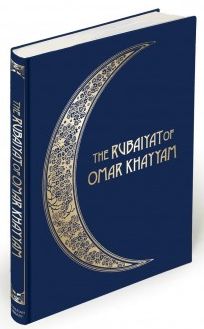 Bodleian Library issued a reprint of the edition of the Rubáiyát that was illustrated by René Bull (1872-1942). Bull started his career studying engineering in Paris where he soon switched to the art of illustrating. When he settled in London in 1892 he started to draw for newspapers and magazines, and from 1898 till 1900 he worked as a photographer in India, Sudan and South Africa, where he covered several campains. Bull also illustrated “The Arabian Nights”, “The Russian Ballet” and “Andersen’s Fairy Tales”.
Bodleian Library issued a reprint of the edition of the Rubáiyát that was illustrated by René Bull (1872-1942). Bull started his career studying engineering in Paris where he soon switched to the art of illustrating. When he settled in London in 1892 he started to draw for newspapers and magazines, and from 1898 till 1900 he worked as a photographer in India, Sudan and South Africa, where he covered several campains. Bull also illustrated “The Arabian Nights”, “The Russian Ballet” and “Andersen’s Fairy Tales”. Michael Skau, emeritus professor with the University of Nebraska at Omaha, recently published an article in the Journal of Popular Culture titled: “Jack Kerouac’s Rubáiyát: The Influence of Omar Khayyám” (vol. 48, No. 3, 2015).
Michael Skau, emeritus professor with the University of Nebraska at Omaha, recently published an article in the Journal of Popular Culture titled: “Jack Kerouac’s Rubáiyát: The Influence of Omar Khayyám” (vol. 48, No. 3, 2015).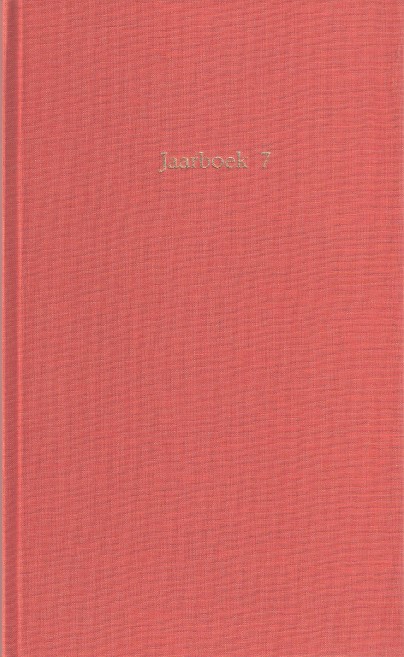 Jaarboek 7. 25 jaar Genootschap is now published, as always by Avalon Pers, Woubrugge. The book contains a number of shorter articles in which the members of the Club look back onto their membership. Jos Biegstraaten, president from 1990 till 2014, presents a short history of the Society. Hans de Bruijn ponders on the eternal and unanswered questions surrounding the origins of the rubáiyát. Jos Coumans explains how and why he started to collect the editions of the rubáiyát. For Marco Goud the exploration of life and work of the Dutch poet P.C. Boutens leads to confrontations with Khayyám’s influence on Boutens’ work he cannot evade. Rokus de Groot first encountered Khayyám’s poetry in the leather workshop of Stavros Melissinos in Athens, who presented him with a signed copy of his ‘Persian Rubáiyát’. Johan ter Haar is fascinated by the diversity of interpretations of Khayyám’s poetry that range from pure mysticism to sheer nihilism, and Remi Hauman looks at the rubáiyát as a collective, national oeuvre by various Persian ghostwriters, with international dimensions. For Dirk Meursing the Society was a useful and joyful resource while working on his own translation, and Asghar Seyed-Gohrab, now president, remembers how in his youth in Tehran he was fascinated by the secrets and mysteries that Khayyám’s verses seemed to conjure. Jos Biegstraaten finally describes how Khayyám influenced the work of the Dutch graphic artist Siep van den Berg.
Jaarboek 7. 25 jaar Genootschap is now published, as always by Avalon Pers, Woubrugge. The book contains a number of shorter articles in which the members of the Club look back onto their membership. Jos Biegstraaten, president from 1990 till 2014, presents a short history of the Society. Hans de Bruijn ponders on the eternal and unanswered questions surrounding the origins of the rubáiyát. Jos Coumans explains how and why he started to collect the editions of the rubáiyát. For Marco Goud the exploration of life and work of the Dutch poet P.C. Boutens leads to confrontations with Khayyám’s influence on Boutens’ work he cannot evade. Rokus de Groot first encountered Khayyám’s poetry in the leather workshop of Stavros Melissinos in Athens, who presented him with a signed copy of his ‘Persian Rubáiyát’. Johan ter Haar is fascinated by the diversity of interpretations of Khayyám’s poetry that range from pure mysticism to sheer nihilism, and Remi Hauman looks at the rubáiyát as a collective, national oeuvre by various Persian ghostwriters, with international dimensions. For Dirk Meursing the Society was a useful and joyful resource while working on his own translation, and Asghar Seyed-Gohrab, now president, remembers how in his youth in Tehran he was fascinated by the secrets and mysteries that Khayyám’s verses seemed to conjure. Jos Biegstraaten finally describes how Khayyám influenced the work of the Dutch graphic artist Siep van den Berg.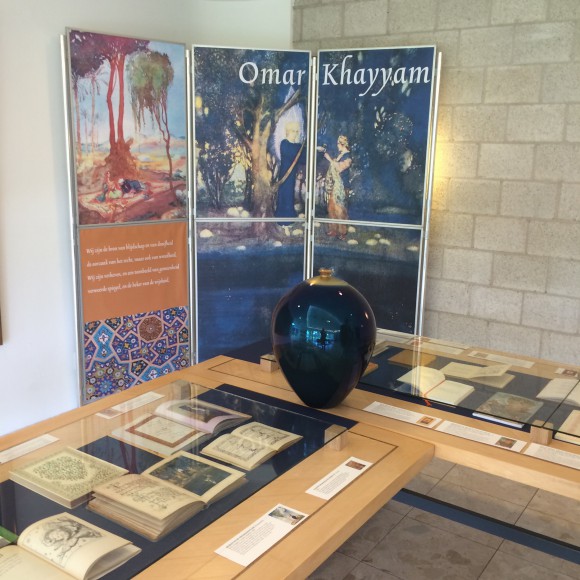 A short video clip was made of the exhibition at the Sufi Masters of Love conference, held June 13th, 2015. (See the previous
A short video clip was made of the exhibition at the Sufi Masters of Love conference, held June 13th, 2015. (See the previous 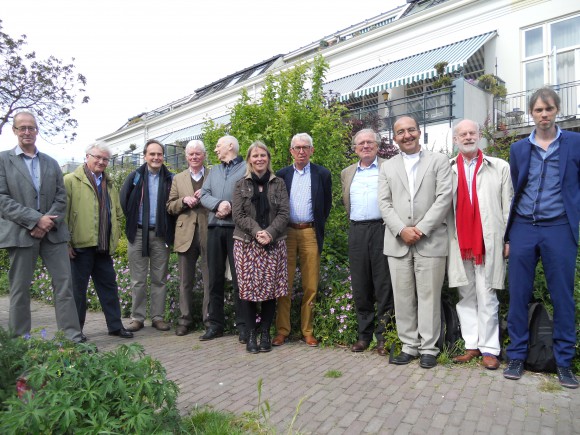 From left to right: Jos Coumans, Hans de Bruijn, Marco Goud, Dirk Meursing, Jos Biegstraaten, Gabrielle van den Berg, Johan ter Haar, Jan Keijser, Asghar Seyed-Gohrab, Rokus de Groot, Remi Hauman.
From left to right: Jos Coumans, Hans de Bruijn, Marco Goud, Dirk Meursing, Jos Biegstraaten, Gabrielle van den Berg, Johan ter Haar, Jan Keijser, Asghar Seyed-Gohrab, Rokus de Groot, Remi Hauman.